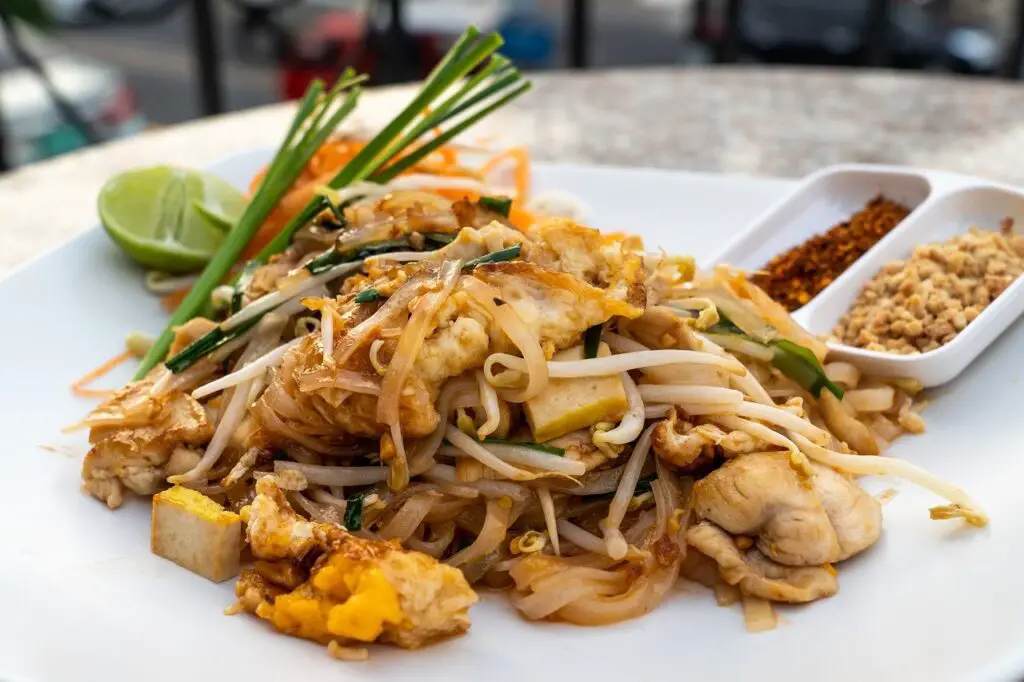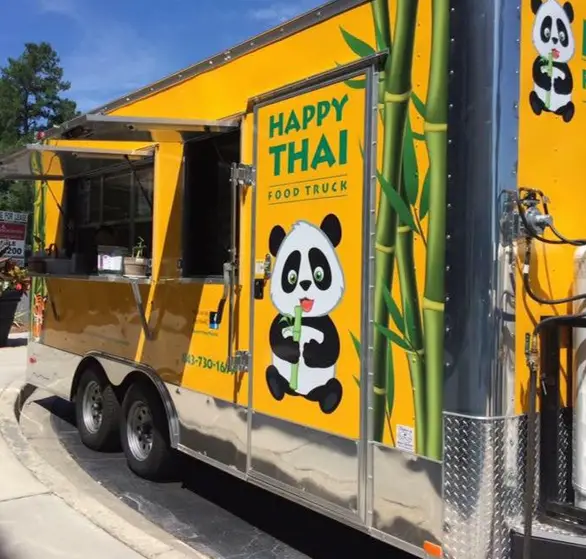Thai street food is a famous part of Thailand’s identity. In short, their country’s cuisine is unique and unmatched, offering an array of flavors that range from sweet and sour to spicy and savory.
This article will guide you through the vibrant world of Thai street food, detailing the types of dishes you can expect, diving into each dish’s unique flavors, and exploring regional variations and modern fusion trends, including Thai food’s global influence.
Classic Thai Street Food Dishes
- Pad Thai: Perhaps the most famous Thai street food dish, Pad Thai is a stir-fried noodle dish, typically made with shrimp or chicken, tofu, peanuts, scrambled egg, and bean sprouts, seasoned with fish sauce, sugar, tamarind paste, and red chili pepper.

- Som Tam (Green Papaya Salad): A spicy salad made from shredded unripe papaya, mixed with tomatoes, carrots, peanuts, dried shrimp, runner beans, palm sugar, tamarind pulp, fish sauce, lime juice, garlic, and plenty of chilies.

- Moo Ping (Grilled Pork Skewers): Marinated pork skewers that are grilled and often served with sticky rice. The marinade usually includes coconut milk, garlic, soy sauce, and sugar.

- Khao Niew Ma Muang (Mango Sticky Rice): A popular dessert, it consists of sticky rice with fresh mango and a sweet coconut milk sauce.

- Tom Yum Goong (Spicy Shrimp Soup): A famous Thai soup known for its distinct hot and sour flavors, prepared with shrimp, mushrooms, tomatoes, lemongrass, galangal, and kaffir lime leaves.

Lesser Known Regional Variations and Fusion Dishes
- Chiang Mai’s Khao Soi: A northern Thai dish, Khao Soi is a creamy coconut curry noodle soup traditionally made with chicken or beef.
- Isaan Sausage: A northeastern-style grilled sausage known for its sour and spicy flavor, typically made from ground pork, rice, and a unique blend of spices.
- Fusion Dishes: Thai cuisine has been embraced by fusion, especially in urban areas and international Thai communities. Examples include Thai-inspired tacos with green curry chicken or Tom Yum-flavored pizzas. These are quite rare to come across but are delicious.
Thai Street Food Outside of Thailand
Thai cuisine has been enthusiastically received globally, with adaptations seen in various countries:
- In Western countries, Thai food often includes adjustments to suit local palates, such as reducing the spice levels significantly or incorporating non-traditional ingredients like avocado. Even still, the food clearly has authenticity, it has just been altered.
- In neighboring Asian countries such as Laos and Cambodia, there’s a blend of Thai and local flavors, creating unique hybrid dishes. These are sold as street food, but rarely make it to Western food trucks.
Fusion Trends
- Vegan and Vegetarian Adaptations: With growing health and environmental consciousness, many Thai street food dishes are now available in vegan and vegetarian versions, using tofu or tempeh as substitutes for meat. It’s not uncommon to see vegetarian Pad Thai as this dish is flavourful enough without the need to add meat.
- Health-conscious Options: Lighter versions of Thai dishes, focusing on fresh vegetables and lean proteins, are increasingly popular, catering to health-conscious consumers. While these are not typically associated with street food, they can be cooked at home.
Thai street food, with its complex flavors and varied textures, offers an immersive experience of Thailand’s rich culinary culture. The spirit of Thai cuisine is evident in its bold flavors, aromatic spices, and harmonious balance of sweet, sour, salty, and spicy elements.

